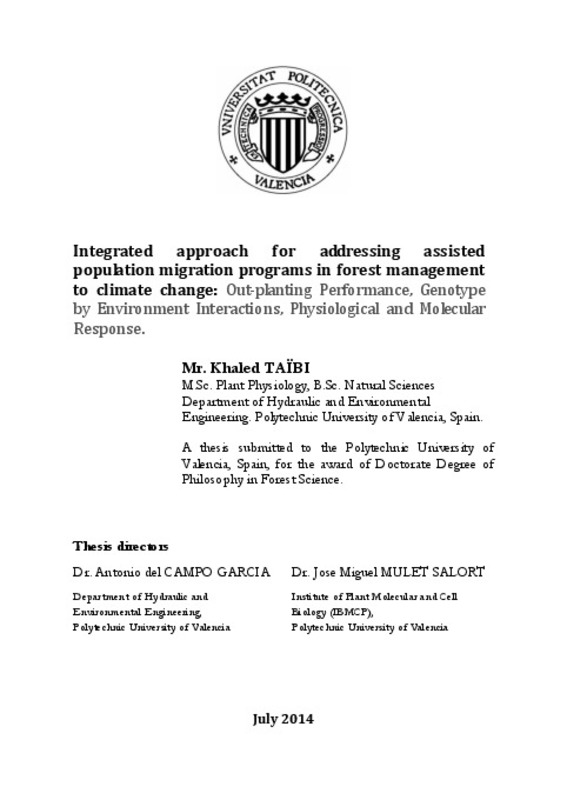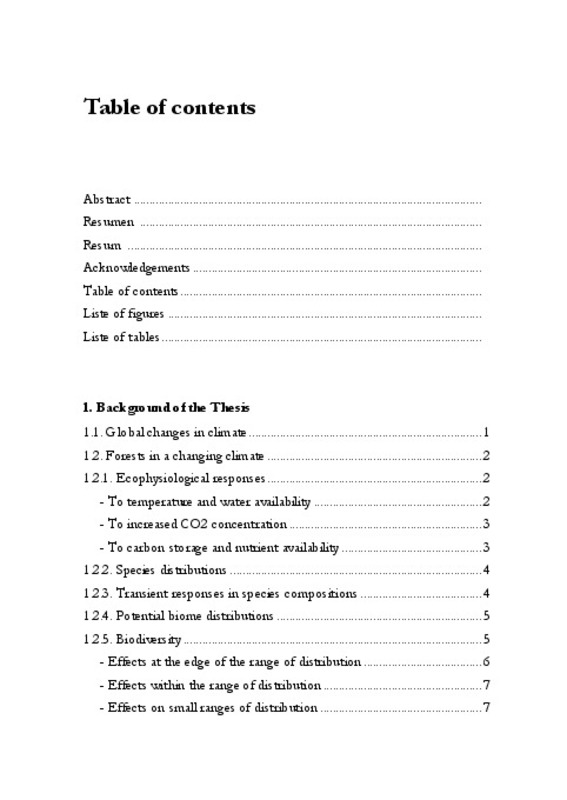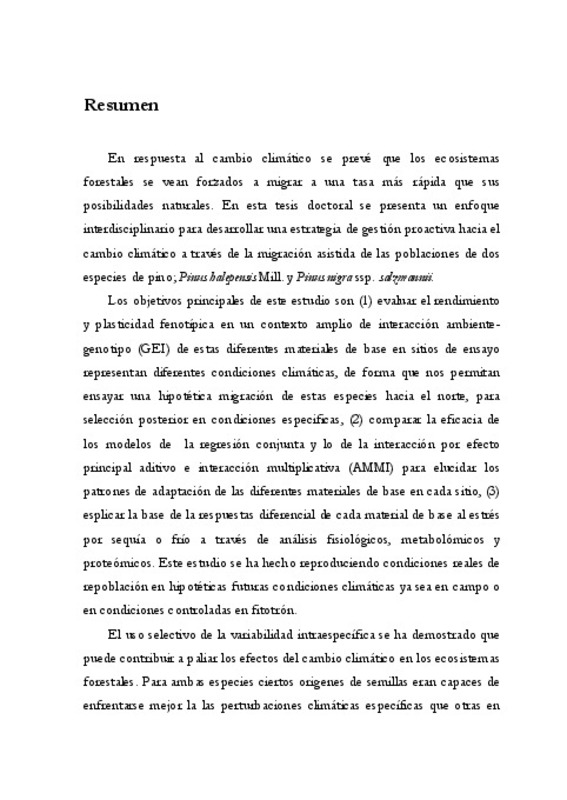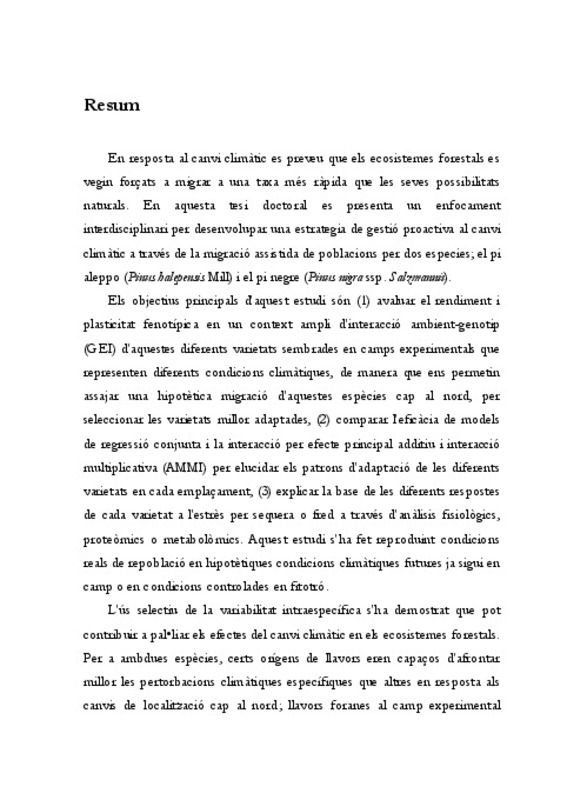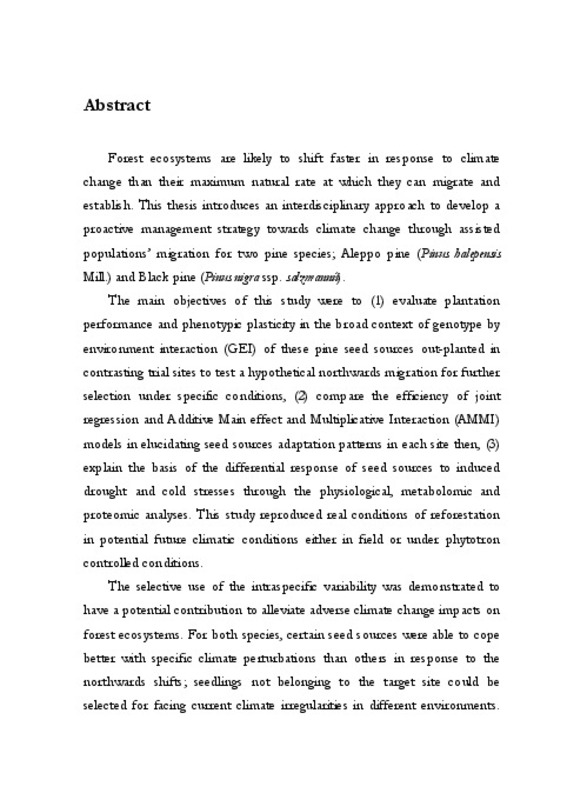|
Resumen:
|
Abstract
Forest ecosystems are likely to shift faster in response to climate
change than their maximum natural rate at which they can migrate and
establish. This thesis introduces an interdisciplinary approach to develop ...[+]
Abstract
Forest ecosystems are likely to shift faster in response to climate
change than their maximum natural rate at which they can migrate and
establish. This thesis introduces an interdisciplinary approach to develop a
proactive management strategy towards climate change through assisted
populations’ migration for two pine species; Aleppo pine (Pinus halepensis
Mill.) and Black pine (Pinus nigra ssp. salzmannii).
The main objectives of this study were to (1) evaluate plantation
performance and phenotypic plasticity in the broad context of genotype by
environment interaction (GEI) of these pine seed sources out-planted in
contrasting trial sites to test a hypothetical northwards migration for further
selection under specific conditions, (2) compare the efficiency of joint
regression and Additive Main effect and Multiplicative Interaction (AMMI)
models in elucidating seed sources adaptation patterns in each site then, (3)
explain the basis of the differential response of seed sources to induced
drought and cold stresses through the physiological, metabolomic and
proteomic analyses. This study reproduced real conditions of reforestation
in potential future climatic conditions either in field or under phytotron
controlled conditions.
The selective use of the intraspecific variability was demonstrated to
have a potential contribution to alleviate adverse climate change impacts on
forest ecosystems. For both species, certain seed sources were able to cope
better with specific climate perturbations than others in response to the
northwards shifts; seedlings not belonging to the target site could be
selected for facing current climate irregularities in different environments.
Abstract
Here, provenances moved from slightly different transfer distance metrics
were the best performers. The main problem is the high expected seedlings
mortality due to freezing events and drought stress mainly for seedlings
belonging to warmer provenances. Seed sources phenotypic plasticity was
low to moderate for height and diameter growth and the environmental
effect had a great influence on their performance variation. The AMMI
models demonstrated higher adequacy to analyse complex GEI than the
joint regression analysis. An important finding is that specific adaptation to
adverse environmental conditions was coupled with low phenotypic
plasticity responses.
Differences among Aleppo pine seed sources subjected to induced
drought conditions were significant for chlorophyll fluorescence, pigments
and soluble sugars contents. However, induced cold stress changes
transpiration rate, stomatal conductance, pigments and glucose contents.
The decrease in photosynthesis under drought, unlike to cold stress, was
due to stomatal closure. At the considered metabolomic level, drought
tolerance was related to the decrease of glucose and fructose and the
increase of sucrose contents in needles. However, the cold tolerance was
associated to the decrease of glucose and the increase of sucrose and
fructose contents. At the proteomic level, most of the identified proteins
were related to the transcriptional machinery and sugar metabolism. The
presence of enzyme related to the sulphur amino-acids metabolism could be
the limiting factor for drought stress in Aleppo pine.
Keywords
Assisted population migration, Reforestation, Pinus halepensis, Pinus nigra ssp.
salzmannii, Seed Sources, Out-planting performance, Survival, Growth,
Phenotypic Plasticity, Genotype by Environment Interaction, Adaptation,
Physiology, Metabolomic, Proteomic.
[-]
|






